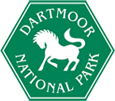Upland Heathland
Upland heathland is dominated by dwarf shrubs, particularly heather and western gorse and covers most of the open moor on Dartmoor which is not covered by the deep peat of blanket bog. It also occurs in newtakes (walled parts of common land enclosed in the 19th century), where it is often in better condition than on the open moor. There are about 11,500 hectares (ha) of heather moorland on Dartmoor.
The upland heathland of Dartmoor is of international importance mainly because most of the vegetation communities present are extremely rare outside the UK. Upland heathland is recognised as a habitat requiring special conservation effort under the EU Habitats Directive 1994.
Typical plants of Dartmoor's upland heathland are heather, bilberry, cross-leaved heath, western gorse, purple moor grass and bristle bent grass.
Characteristic animals include emperor moth and fox moth, the adder and common lizard, and among the birds, raven, meadow pipit, skylark and stonechat. Other insects include the rare and declining high brown fritillary butterfly, which live in bracken stands, and the green hairstreak butterfly.
The red grouse is a key species for this habitat and there are about 70 - 100 pairs of red grouse present on Dartmoor. It is listed as being of medium conservation concern because its numbers are falling.
Another key species is the skylark. Fortunately it is still common throughout Dartmoor, heather and grass moorland being one of its favoured habitats. However, numbers have fallen nationally by 54% over the last 25 years, giving cause for grave concern. If we are not careful, the glorious sound of skylarks singing overhead during the spring and summer will be a thing of the past.
The ring ouzel is another special bird occurring on Dartmoor's upland heathland. This handsome thrush has been recently listed as a species of high conservation concern due to continued declines. Fewer than 10 pairs of ring ouzel now breed on Dartmoor.
Substantial areas of heather moorland occur within four Sites of Special Scientific Interest (SSSIs) on Dartmoor - North Dartmoor, South Dartmoor, East Dartmoor and Holne Woodlands. A relatively small area occurs within the Wistman's Wood National Nature Reserve. Dartmoor National Park own large areas at Holne Moor and Haytor, while the National Trust have another substantial area around the Upper Plym valley. Much of the moorland is now managed under environmental land management schemes.
The main threats to heather moorland are overgrazing and too frequent swaling (burning). Leisure activities, military training, gorse and bracken invasion, nutrient enrichment and acid rain and other factors which can have adverse impacts on some areas. Much of the moorland is common land and the Commoner’s have a duty of care to look after it.
